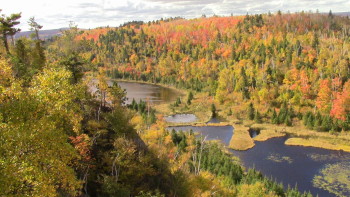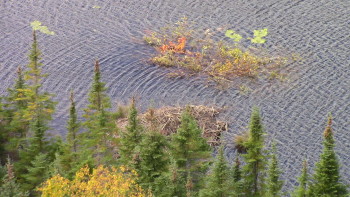There were plenty of chores to be done this fall – finish picking the last of the apples, harvesting the carrots, beets, and other root crops, transplanting wildflowers into the meadow and beneath the big spruces, extracting the honey from the beehive, and getting the firewood in. But the skies were bright blue, the temperatures were in the 50s, and it was our combined birthdays-and-anniversary weekend. The chores could wait during this first week of October while the colors of maples in northern Minnesota peaked.
And so it was in search of some brilliant sugar and mountain maples that we hiked along the Superior Hiking Trail on October 3 of this year. We struck out going northeast along the trail where it crosses State Highway 1 near Finland, Minnesota, and headed towards Wolf Lake and Canada. A mile along and five hundred feet higher, we took a narrow spur trail a half mile around a hard knob of Precambrian basalt. A half hour later, we arrived at a cliff at the trail’s end. The ridge opposite us was splashed with scarlet, salmon, and orange as if J.M.W. Turner had used giant maple brushes. The deep greens of spruce, fir, and pines punctuated the maple canopy. No houses or cabins could be seen, not even smoke from a chimney. It was not too difficult to imagine that we had stepped back to the voyageurs’ times. It was everything we expected and more.
 When we looked down into the valley, we saw something we didn’t expect. The USGS topographic map had led us to think that we would see two ponds connected one to the other by a short and narrow stream. There were indeed two ponds and we were above the upper pond. But the water did not flow from the upper pond to the lower via a stream but instead through a broad mosaic of floating bogs, pools, and sedge meadows blanketing the valley floor. Something had raised the water table enough to turn the narrow stream into complex set of wetlands.
When we looked down into the valley, we saw something we didn’t expect. The USGS topographic map had led us to think that we would see two ponds connected one to the other by a short and narrow stream. There were indeed two ponds and we were above the upper pond. But the water did not flow from the upper pond to the lower via a stream but instead through a broad mosaic of floating bogs, pools, and sedge meadows blanketing the valley floor. Something had raised the water table enough to turn the narrow stream into complex set of wetlands.
 As we scanned the wetland complex, a grass-covered ridge with a concave shape caught our attention. This ridge appeared to hold the water surface of the upstream pond a meter or two above that of a small pool between the two ponds. (Click on this second photo to enlarge it and see if you can find this ridge). This ridge was the answer to our question of what happened to the stream. It was a beaver dam. The classic concave shape strengthens it against the mass of water pressing against it from the upper pond. The dam must have been here for at least a few years to trap enough sediment for the grasses to have something to root in. Upstream, the dam raised the water table and created shallows for wetland plants to take root. Downstream, it spread the water across the valley floor, drowning the stream in the wetland and pool complex between the ponds. The view before us was a picture-postcard example of how beaver control the hydrology and plant communities of valley floors throughout Minnesota’s North Woods.
As we scanned the wetland complex, a grass-covered ridge with a concave shape caught our attention. This ridge appeared to hold the water surface of the upstream pond a meter or two above that of a small pool between the two ponds. (Click on this second photo to enlarge it and see if you can find this ridge). This ridge was the answer to our question of what happened to the stream. It was a beaver dam. The classic concave shape strengthens it against the mass of water pressing against it from the upper pond. The dam must have been here for at least a few years to trap enough sediment for the grasses to have something to root in. Upstream, the dam raised the water table and created shallows for wetland plants to take root. Downstream, it spread the water across the valley floor, drowning the stream in the wetland and pool complex between the ponds. The view before us was a picture-postcard example of how beaver control the hydrology and plant communities of valley floors throughout Minnesota’s North Woods.
The dam seemed in good condition, without a single breach along its entire length. A dam in good condition needs an active beaver colony to repair breaches caused by floods and otters and minks tunneling through it. The colony’s lodge was directly in front of us in deep water, protected from the cold northeast winds by the cliff atop which we were standing. (Click on the second photo again and see if you can locate the lodge).
Two clues told us that there was an active colony in this lodge. First, the lodge itself was in good repair and not covered by grasses and other plants. When a lodge is occupied, the beaver gnaw on the roots of plants which become established on it, thereby killing them. But the best clue was the cache of branches and twigs a meter or two in front of the lodge. This food cache would supply the beaver colony with their food for the winter. The yellow and red leaves remaining on these branches told us that the beaver had recently been gathering aspen and a little maple, their favorite forage species in this part of Minnesota. The maples most lik ely were harvested from across the pond and floated back to the cache, but the aspens probably came from the stand just now turning yellow immediately below us on the slope forming the shore of the pond next to the lodge.
ely were harvested from across the pond and floated back to the cache, but the aspens probably came from the stand just now turning yellow immediately below us on the slope forming the shore of the pond next to the lodge.
After spending a little while drinking a cup of tea apiece from our thermos and admiring the good sense of these beavers to build their pond in such a magnificent setting, we left the colony to continue with its preparations for the winter.
For Further Reading
Morgan, L.H. 1868. The American Beaver and His Works. J.B. Lippincott & Co., Philadelphia (republished in 1986 by Dover Publications, Mineola, NY)
Naiman, R.J., J.M. Melillo, and J. Hobbie. 1986. Ecosystem alteration of boreal forest streams by beaver (Castor canadensis). Ecology 67: 1254-1269.
Naiman, R.J., C.A. Johnston, and J. C. Kelley. 1988. Alteration of North American streams by beaver. Bioscience 38: 753-762.